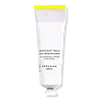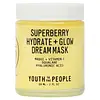What's inside
What's inside
 Key Ingredients
Key Ingredients

 Benefits
Benefits

 Concerns
Concerns

 Ingredients Side-by-side
Ingredients Side-by-side

Water
Skin ConditioningGlycerin
HumectantGlyceryl Stearate
EmollientCetyl Alcohol
EmollientNeopentyl Glycol Diheptanoate
EmollientGlyceryl Caprylate
EmollientSqualane
EmollientPalmitoyl Tripeptide-38
Skin ConditioningCaprae Lac
Skin ConditioningMilk Protein
Skin ConditioningLactose
HumectantBifida Ferment Lysate
Skin ConditioningBakuchiol
AntimicrobialMelatonin
AntioxidantHyaluronic Acid
HumectantIsododecane
EmollientMelia Azadirachta Flower Extract
Skin ConditioningStearic Acid
CleansingGlyceryl Stearate Citrate
EmollientHydroxyacetophenone
AntioxidantPanthenol
Skin ConditioningCoccinia Indica Fruit Extract
Skin ConditioningCarbomer
Emulsion StabilisingAllantoin
Skin ConditioningXanthan Gum
EmulsifyingCaprylhydroxamic Acid
Glyceryl Laurate
EmollientBetaine
HumectantSodium Hydroxide
BufferingCentella Asiatica Extract
CleansingHydroxypropyl Cyclodextrin
MaskingSpinacia Oleracea Leaf Extract
Skin ConditioningSodium Carbonate
BufferingPropanediol
SolventTephrosia Purpurea Seed Extract
Skin ConditioningAcetyl Hexapeptide-8
HumectantGardenia Florida Fruit Extract
Skin ConditioningMaltodextrin
AbsorbentWater, Glycerin, Glyceryl Stearate, Cetyl Alcohol, Neopentyl Glycol Diheptanoate, Glyceryl Caprylate, Squalane, Palmitoyl Tripeptide-38, Caprae Lac, Milk Protein, Lactose, Bifida Ferment Lysate, Bakuchiol, Melatonin, Hyaluronic Acid, Isododecane, Melia Azadirachta Flower Extract, Stearic Acid, Glyceryl Stearate Citrate, Hydroxyacetophenone, Panthenol, Coccinia Indica Fruit Extract, Carbomer, Allantoin, Xanthan Gum, Caprylhydroxamic Acid, Glyceryl Laurate, Betaine, Sodium Hydroxide, Centella Asiatica Extract, Hydroxypropyl Cyclodextrin, Spinacia Oleracea Leaf Extract, Sodium Carbonate, Propanediol, Tephrosia Purpurea Seed Extract, Acetyl Hexapeptide-8, Gardenia Florida Fruit Extract, Maltodextrin
Water
Skin ConditioningGlycerin
HumectantHelianthus Annuus Seed Oil
EmollientIsopropyl Myristate
EmollientGlyceryl Stearate
EmollientBetaine
HumectantCetyl Alcohol
EmollientStearic Acid
CleansingTetrahexyldecyl Ascorbate
AntioxidantOpuntia Tuna Flower/Stem Extract
Skin ConditioningEuterpe Oleracea Fruit Extract
Lycium Barbarum Fruit Extract
AstringentAristotelia Chilensis Fruit Extract
Skin ConditioningMoringa Oleifera Leaf Extract
Skin ConditioningGlyceryl Stearate Citrate
EmollientTocopheryl Acetate
AntioxidantGlyceryl Laurate
EmollientSqualane
EmollientCarbomer
Emulsion StabilisingHyaluronic Acid
HumectantAllantoin
Skin ConditioningPanthenol
Skin ConditioningEthylhexylglycerin
Skin ConditioningXanthan Gum
EmulsifyingPhenoxyethanol
PreservativeRiboflavin
Cosmetic ColorantTriethyl Citrate
MaskingCitrus Aurantium Dulcis Peel Oil
MaskingGamma-Undecalactone
PerfumingGamma-Decalactone
PerfumingTocopherol
AntioxidantLimonene
PerfumingWater, Glycerin, Helianthus Annuus Seed Oil, Isopropyl Myristate, Glyceryl Stearate, Betaine, Cetyl Alcohol, Stearic Acid, Tetrahexyldecyl Ascorbate, Opuntia Tuna Flower/Stem Extract, Euterpe Oleracea Fruit Extract, Lycium Barbarum Fruit Extract, Aristotelia Chilensis Fruit Extract, Moringa Oleifera Leaf Extract, Glyceryl Stearate Citrate, Tocopheryl Acetate, Glyceryl Laurate, Squalane, Carbomer, Hyaluronic Acid, Allantoin, Panthenol, Ethylhexylglycerin, Xanthan Gum, Phenoxyethanol, Riboflavin, Triethyl Citrate, Citrus Aurantium Dulcis Peel Oil, Gamma-Undecalactone, Gamma-Decalactone, Tocopherol, Limonene
 Reviews
Reviews

Ingredients Explained
These ingredients are found in both products.
Ingredients higher up in an ingredient list are typically present in a larger amount.
Allantoin is a soothing ingredient known for its protective and moisturizingg properties. Because of this, it is often added to products with strong active ingredients.
Studies show higher concentrations of this ingredient can promote wound healing.
Though it can be derived from the comfrey plant, allantoin is produced synthetically for cosmetic products to ensure purity.
Learn more about AllantoinBetaine is a common humectant (a substance that promotes retention of moisture). It's known to be gentle on the skin and can help balance hydration.
This ingredient is best for improving hydration and soothing irritated skin. Studies also show it helps even out skin tone.
Fun fact: Betaine is naturally created in the skin and body. The kind found within cosmetic products can be either plant-derived or synthetic.
Another name for betaine is trimethylglycine.
Learn more about BetaineCarbomer is a polymer of acrylic acid. Its main role is to create a gel consistency.
A high amount of carbomer can cause pilling or balling up of products. Don't worry, most products contain 1% or less of carbomer.
Cetyl Alcohol is a fatty alcohol. Fatty Alcohols are most often used as an emollient or to thicken a product.
Its main roles are:
Though it has "alcohol" in the name, it is not related to denatured alcohol or ethyl alcohol.
The FDA allows products labeled "alcohol-free" to have fatty alcohols.
Learn more about Cetyl AlcoholGlycerin is already naturally found in your skin. It helps moisturize and protect your skin.
A study from 2016 found glycerin to be more effective as a humectant than AHAs and hyaluronic acid.
As a humectant, it helps the skin stay hydrated by pulling moisture to your skin. The low molecular weight of glycerin allows it to pull moisture into the deeper layers of your skin.
Hydrated skin improves your skin barrier; Your skin barrier helps protect against irritants and bacteria.
Glycerin has also been found to have antimicrobial and antiviral properties. Due to these properties, glycerin is often used in wound and burn treatments.
In cosmetics, glycerin is usually derived from plants such as soybean or palm. However, it can also be sourced from animals, such as tallow or animal fat.
This ingredient is organic, colorless, odorless, and non-toxic.
Glycerin is the name for this ingredient in American English. British English uses Glycerol/Glycerine.
Learn more about GlycerinGlyceryl Laurate isn't fungal acne safe.
Glyceryl Stearate is a mix of glycerin and stearic acid.
It is used to stabilize the mixing of water and oil ingredients. By preventing these ingredients from separating, it can help elongate shelf life. It can also help thicken the product's texture.
As an emollient, it helps soften skin and supports barrier-replenishing ingredients.
In cosmetics, Glyceryl Stearate is often made from vegetable oils or synthetically produced.
This ingredient may not be fungal-acne safe
Fun fact: The human body also creates Glyceryl Stearate naturally.
Learn more about Glyceryl StearateGlyceryl Stearate Citrate is a citric acid ester of glyceryl stearate.
It is an emulsifier, emollient, and a surfactant.
Emulsifiers help stabilize a product. It does this by preventing certain ingredients from separating. Common ingredients include oils and water, which do not mix naturally. Emulsifiers have properties that help keep ingredients such as these together.
Emollients help soothe and soften the skin. They do this by creating a protective film on your skin. This barrier helps trap moisture and keeps your skin hydrated. Emollients may be effective at treating dry or itchy skin.
Surfactants help gather oils, dirt, and other pollutants from the skin. This helps them to be easily rinsed away.
Learn more about Glyceryl Stearate CitrateHyaluronic acid is naturally found in healthy skin. It is a humectant, meaning it draws moisture to your skin.
This ingredient helps hydrate, soothe, and protect the skin.
What makes hyaluronic acid so hydrating? It has the capacity to bind or hold large amounts of water.
Fun fact: It is already naturally found in our bodies, such as the fluids of our eyes and our joints.
Studies find this ingredient to have anti-inflammatory and anti-microbial properties. This can help speed up wound-healing.
Hyaluronic acid can be irritating if the molecule has a low-molecular weight, or if the molecules are small.
One study found low-molecular weight hyaluronic acid to be pro-inflammatory, meaning some people may experience irritation. This is because our bodies use hyaluronic acid in the wound-healing process to signal to our bodies, via irritation, that something needs healing.
The same study found high-molecular weight hyaluronic acid to be anti-inflammatory.
These are some other common types of Hyaluronic Acid:
Learn more about Hyaluronic AcidPanthenol is a common ingredient that helps hydrate and soothe the skin. It is found naturally in our skin and hair.
There are two forms of panthenol: D and L.
D-panthenol is also known as dexpanthenol. Most cosmetics use dexpanthenol or a mixture of D and L-panthenol.
Panthenol is famous due to its ability to go deeper into the skin's layers. Using this ingredient has numerous pros (and no cons):
Like hyaluronic acid, panthenol is a humectant. Humectants are able to bind and hold large amounts of water to keep skin hydrated.
This ingredient works well for wound healing. It works by increasing tissue in the wound and helps close open wounds.
Once oxidized, panthenol converts to pantothenic acid. Panthothenic acid is found in all living cells.
This ingredient is also referred to as pro-vitamin B5.
Learn more about PanthenolSqualane is an emollient that helps the skin hold onto moisture. It's an oily liquid that occurs naturally in certain types of fish and plant oils.
Because squalane boosts hydration in the skin, it also comes with plenty of benefits: it is an antioxidant and can help fight free radicals and skin damage. Squalane is also found to have a detoxifying effect when applied.
Squalane comes from squalene, which occurs naturally within the sebum of our skin. It is one of the oils our skin produces to keep itself hydrated. Squalane is the hydrogenated version of squalene and has a longer shelf life.
Research shows that squalane is non-irritating (even at 100% concentration).
In general, it's a fantastic ingredient. It does a great job at hydrating the skin, and it's suitable for those with sensitive skin.
The source of squalane may impact malassezia / fungal acne. This is because olive oil derived squalane can contain impurities such as fatty acids and plant waxes. Sugarcane derived squalane is recommended for anyone with malassezia concerns.
Is squalane vegan?
This depends on the source. Squalane can be derived from both plants and animals. Most squalane used in skincare comes from plants.
Please note: the source of squalane is only known if disclosed by the brand. We recommend reaching out to the brand if you have any questions about their squalane.
Read more about squalene with an "e".
Is squalane an oil?
Squalane is often called an oil, but it’s technically not; it’s a hydrocarbon, meaning it’s only made of carbon and hydrogen, unlike true oils which are triglycerides made of fatty acids and glycerol.
The term “oil-free” isn’t regulated, so companies can define it however they want. Some exclude all oils, while others just avoid mineral oil or comedogenic oils.
While some people avoid oils thinking they cause breakouts, the right kind of oil (or oil-like ingredient like squalane) can actually help balance and hydrate your skin. It’s worth testing out simple oils or squalane to see what works best for your skin.
Learn more about SqualaneStearic Acid is a fatty acid. It is an emollient, emulsifier, and texture enhancer.
As an emollient, stearic acid helps soften skin. It aids the skin's protective barrier by preventing water loss. It also provides a gentle cleansing effect without stripping away natural oils.
Stearic acid may also be used to enhance the texture of products. It can add volume and stabilize ingredients such as water and oil. This can help water and oil ingredients from separating.
Sources of stearic acid include animal or vegetable fats/oils such as coconut or shea. It can be naturally found in butter, cocoa butter, shea butter, vegetable fats, and animal tallow.
This ingredient may not be Malassezia folliculitis, or fungal-acne safe.
Learn more about Stearic AcidWater. It's the most common cosmetic ingredient of all. You'll usually see it at the top of ingredient lists, meaning that it makes up the largest part of the product.
So why is it so popular? Water most often acts as a solvent - this means that it helps dissolve other ingredients into the formulation.
You'll also recognize water as that liquid we all need to stay alive. If you see this, drink a glass of water. Stay hydrated!
Learn more about WaterXanthan gum is used as a stabilizer and thickener within cosmetic products. It helps give products a sticky, thick feeling - preventing them from being too runny.
On the technical side of things, xanthan gum is a polysaccharide - a combination consisting of multiple sugar molecules bonded together.
Xanthan gum is a pretty common and great ingredient. It is a natural, non-toxic, non-irritating ingredient that is also commonly used in food products.
Learn more about Xanthan Gum